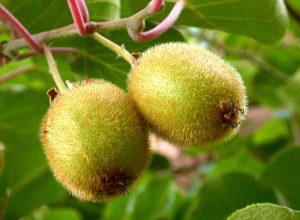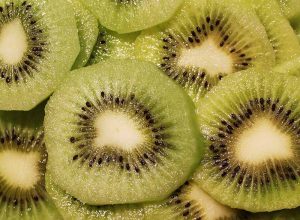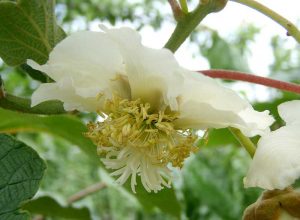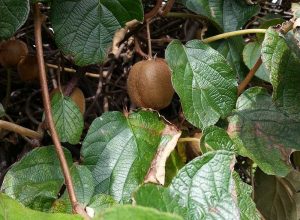Kiwi – Actinidia Deliciosa


Introduced in Italy little more than forty years ago, the Actiidia Chinensis, better known with the common name of Kiwi, rapidly reached success both with the consumers, and the farmers, making our Country the biggest producers of Kiwi in the world.
Italy also reigns in the research and experimentation. Two distinguished researches of the University of Udine, selected and registered the Kiwi variety with the yellow pulp named Soreli with exceptional organoleptic features, of unitary and rustic production, superior to the Hayward variety, cultivated everywhere, that in 2009 gave them the exclusive rights in the world.
The Kiwi is originally from the very rainy and damp Valleys of the Blue river that divides Northern China from Southern China (Yangz-tze), with hot summers and cold winters, where it grows spontaneously, it reached us from New Zealand, where a nursery farmer (W. Hayward), at the beginning of the last century began reproducing it and selectin the best varieties. It was that nursery farmer who chose that variety, that takes his name, and that still today, is known around the world as the best under all aspects, from the taste, dimensions, storage and, with regard to the plant, simple cutivation.
Appreciated in all the Continent, although originally from China, it was first exported in great quantity from New Zealand, it’s today universally known with the name of the bird symbol of that nation: the kiwi.
A very vigorous plant, it is a vine that can easily reach ten metres long, it has big leaves with a very long stem and to cultivate it a structure is necessary.
In case of strong wind, the new vegetation that have a grassy consistency are prone to breakage, for which, in those areas, it’s necessary to plant the kiwi in sheltered places; maturing, the vegetation tends to change and take on the classic consistency of wood. In the summer, they love the hot sunshine, without which the flower buds hardly form; on the other hand, they suffer from the late frost because it kills the new vegetation. Kiwi are very productive plants: from a single plant you can easily have a harvest of over fifty kilograms.
TERRAIN
Although the soil and the climate of our Nation are very different to the ones of the areas of origin, the capability of adaptation of the plant means that you can find cultivations both in the South and in the North. It favours deep, fresh and well drained fertile soil and is of a hue somewhere between white and creamy white, it has a very luxuriant vegetation. The kiwi doesn’t adapt well to soils that are too calcareous, with a ph over 7.5 doesn’t adapt and it tends to suffer from ferric chlorosis. To avoid dangerous root rotting, it’s important that there is no water stagnation.


FLORA AND FRUIT
Actinidia chinensis is a dioica species, that is the plant has flowers and stamen which are only male or have female pistils. This means that in order for it to bear fruit you must have both a male plant and a female plant; if well positioned, a male plant can pollinate 7/10 female plants.
The flowers a relatively large (3/4 cm) the form is that of an open chalice with diverse petals and many pistils and, although showy, bees are not very attracted because they are rich in pollen, but lacking in nectar.
Pollination however, is not only entomophilous (accomplished by insects) but also anemophilous, (accomplished by the wind) This allows for a secure fertilisation of female flowers.
An empiric but valid system, recognizing the female plant from that of the male, means observing the disposition of the flowers: in the male they are numerous and bunched, whilst in the female they are generally at a distance from each other to allow space for the fruit to develop easily.
The fruit is a large berry which can easily exceed 100 grams in weight, wrapped in a resistant brown peel and covered in a brown fuzz; the flesh of the Hayward variety is green with an off white with numerous small black seeds which are not a nuisance to eat.
They are climacteric fruit (see feijoa sellowiana), so they can be picked at the end of October and left to ripen slowly in an allotted place. If you put the fruit in a non airy place which is rather dark but not cold, together with apples, being also climacteric, they develop a gas, etilene, which favours matureingfurthermore betters the organoleptic quality. In this process generally, the organoleptic quality of the apple is lost.
Varieties cultivated by prandini’s Nursery
HAYWARD – cultivar femmina del Kiwi più coltivato al modo
MATUA – maschio, impollinatore dell’Hayward
HAYWARD
TOMURI
JENNY AUTOFERTILE
USE AND HEALTH PROPERTIES
For the easy maintenance and simple commercial distribution, it is unmissable on all the greengrocer’s stalls, it is a typical after dinner fruit in restaurants and present in every home. In cake shops you find it in tarts or small cakes and in the kitchen it is excellent in fruit salads.
The kiwi is very refreshing and thirst quenching and has a high content of vitamin C, second only to small fruits and Summer fruit and has a considerable presents of potassium and vitamin E. The presence potassium and vitamin E. The presence of inositol (vitamin B 7) gives us laxative properties, increases the intestinal motility, and reduces the build up of cholesterol.
PRUNING AND CULTIVATION
Pruning the Actinidie is not the simplest. Being a very vigorous plant for the female, in the Summer time you should begin by eliminating the suckers and the thinning of the vegetation, being careful to shorten the branches which will be needed to revive the plant when potted in winter. This operation apart from lightening the greenery to favour the fruit , and is necessary to give light sun to the fruit itself. In Winter, chopping off the branches that have borne fruit, you should leave those chosen for potting in Summer and proceed with an ulterior thinning. New techniques in potting have recently been introduced which consist of leaving shortened, for two or three years, those branches which have borne fruit: this will impede the plants normal vigorous development and will stimulate the formation of little branches, called spur, with flower buds.
The male plant, instead, it is opportune to pot after flowering simply by thinning and shortening the remaining branches until there greater number of flowers for pollination If planted in suitable terrain, The Actinidie is a plant of few demands; in intensive cultivation or in poor soil, it is an idea to fertilize the plant with a mature manure, or with a good tenary fertilizer with added microelements at the beginning of Spring. With a superficial root system, they need frequent irrigation, it is better to nebulize the leaves in an attempt to create an ambience similar to that of the zones of its Chinese origins.
It suffers few attacks of parasites: attacks from mites (little red spiders) can occur in case of high heat.
Apart from the already mentioned root rotting, there is the chance of fastidious bacteiroses to be eliminated like root tumors (agrobacterium tumefaciens ) and PSA (Pseudomonas syringae actinidiae). For the first, at times its the plant itself that reacts, in any case a specific treatment is always advisable, for the second, PSA, that has recently appeared in Italy, prevention is advisable: often sprinkling the plant with a copper based product is the best solution, if this isn’t enough, you also need to cut a healthy part under the part that has been attacked, that shows itself with as whitish exudation, once it’s in contact with oxygen, it oxidizes and becomes a reddish colour, and burn the cut part. PSA is a bacteria that spreads very easily.
